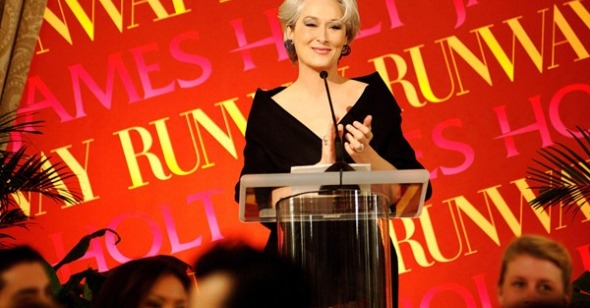Sympathy for the Devil
by Chris Wisniewski
The Devil Wears Prada
Dir. David Frankel, U.S., 20th Century Fox
The only thing surprising about the commercial success of The Devil Wears Prada, David Frankel’s adaptation of Lauren Weisberger’s semi-autobiographical novel, is that anyone finds it surprising at all. Prada is, after all, as old school as a Hollywood film can be—a fashion show, a women’s picture, a meditation on the working woman’s alleged choice between personal happiness and professional success. Prada’s opening weekend reportedly drew an 80% female audience. That’s the kind of demographic appeal that classical Hollywood was built on, and there can be little doubt that the formula that led to Prada’s box office has been responsible for more than a few hits over the past 80 or so years, from both Imitation of Lifes and Mildred Pierce to Working Girl and Baby Boom.
That Prada is a rather conventional sort of beast is apparent from its opening moments. Young Andy Sachs (Anne Hathaway) primps and preens herself in preparation for a job interview. She’s intercut with a series of anonymous New York women, each wearing an outfit more fabulous than dowdy little Andy, hailing their cabs as poor, serious Andy schleps her way via the (gasp) subway from her roomy little one bedroom on the Lower East Side (poor, poor Andy, indeed) to the hallowed halls of Runway Magazine. Worst of all, unlike her competition, Andy eats a bagel for breakfast, and you can best believe the girls of Runway will be all over the scent of those carbs on Andy’s breath like a Labrador retriever on a squirrel. This opening sequence is clearly meant to underscore some sort of contrast, but if that intended effect is actually achieved, it’s more through filmic convention than the substance of anything we see onscreen. No rational person could possibly believe that Anne Hathaway has ever eaten a cream-cheese smothered bagel in her life, and Hathaway has the sort of vacant non-presence that makes her frumpy-but-smarter-than-thou put-on the hardest of sells.
Still, buy it we do, if only because she’s our ticket in to the real show. However unlikely the setup, Andy is quickly established as the naïve but (apparently, though we receive no real evidence of it) clever assistant to Meryl Streep’s Miranda Priestly, a vicious, no-nonsense fashion editor inspired by Vogue chief Anna Wintour. For all the buildup to Streep’s entrance as Priestly-cum-Wintour, her so-called devil burns not with fire and brimstone but pure ice: her cruelty lies not in any sort of brash sadism but in casual indifference—her refusal to learn Andy’s name, the “that’s all” with which she dismisses her assistants.
Andy, meanwhile, feels above the whole thing. She went to Northwestern and has dreams of working at the New Yorker, and so, preposterously, she refuses to play the fashion game for a while, choosing instead to wear her Spring ’01 Gap sweater while outwardly deriding an important belt choice in a meeting. Since the source material is essentially autobiographical, there’s something acutely tiresome and off-putting in Andy’s entitlement and over-it-ness. Andy’s self-importance comes off as Weisberger’s self-promotion, and so I found myself turning against Andy in her mismatched clash of wills and wits with Miranda.
Thankfully, Andy gets some richly deserved smack-downs, and she eventually enlists Runway’s resident gay man Nigel (Stanley Tucci, who turns in a lovely and restrained supporting performance) to make her over. With a quick trip to the sample closet, dowdy Andy becomes the fashionista she was destined to be, and Hathaway goes from frump to glamour girl à la Now, Voyager or, more appropriately (no Bette Davis she), The Princess Diaries. One wonders, in fact, what this film would have been if it had been made seventy years ago with a star like Davis as its lead, someone who could make the frump believable and the glamorous transformation transfixing. Instead, it plays as a tired fait accompli.
Hathaway, and everyone who surrounds her (sorry, Adrian Grenier; blame the writing), is pretty much a snooze, and it’s left to Streep to pick up the slack, by channeling not Bette Davis but a Best of Everything-style Joan Crawford—the hard-as-nails career woman who has foregone, time and again, her own personal happiness for the demands of her career. Ironically, though, there couldn’t be an actress more different than those legendary stars of the classical era than Streep. Old Hollywood was built on the star-turn, the image, the persona. It’s a notion that’s anathema to the way Streep performs. No matter what role she’s playing, Streep has always seemed to disappear into her part, partly through voice and manner, yes, but also through her capacity for empathy. Her Miranda is a hoot, sure, but Streep makes her a fierce and captivating creation by finding Miranda’s human core. Most remarkably, she does it all in a one-, maybe two-minute long sequence; the rest of the time, she’s painting in broad strokes.
For Andy, Prada plays as a dubious and dull fairy tale: she gets the boy and the career; she stands firm to her moral principles; and she keeps the bangs to boot. For Miranda, the world is painted in shades of grey and cerulean, auburn and rust. Hers is the more interesting story, and Streep is our way into the film—we take pleasure as she makes Andy squirm, and we feel the difficult compromises that her professional ambition invites. Streep takes this lopsided mess of a film and performs some kind of strange alchemy through which it becomes not just watchable but oddly poignant. When we talk about acting as an art, surely this is what we mean: the artist doesn’t rise above the material; instead she sinks into it, transforming it not from above but from within.
